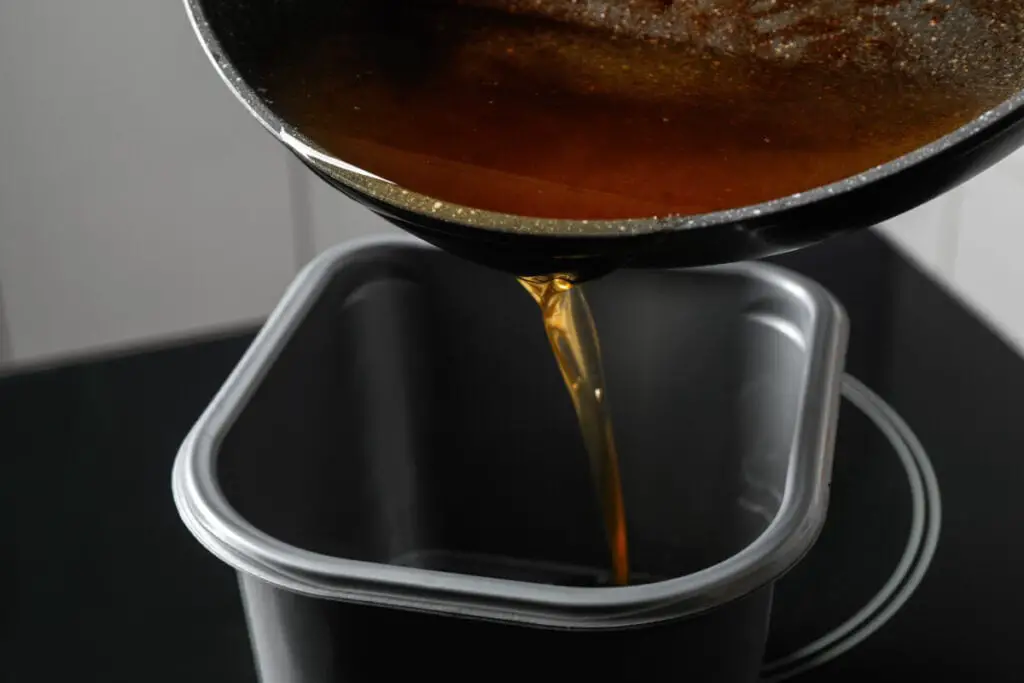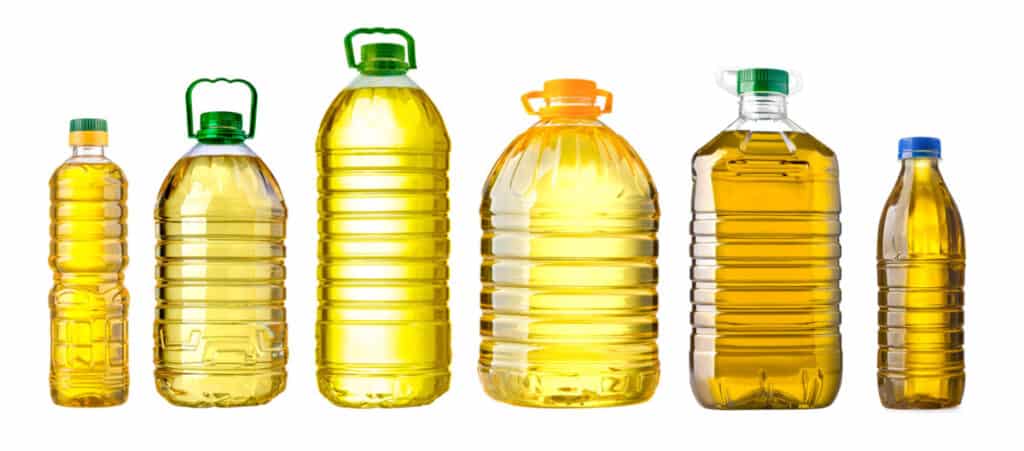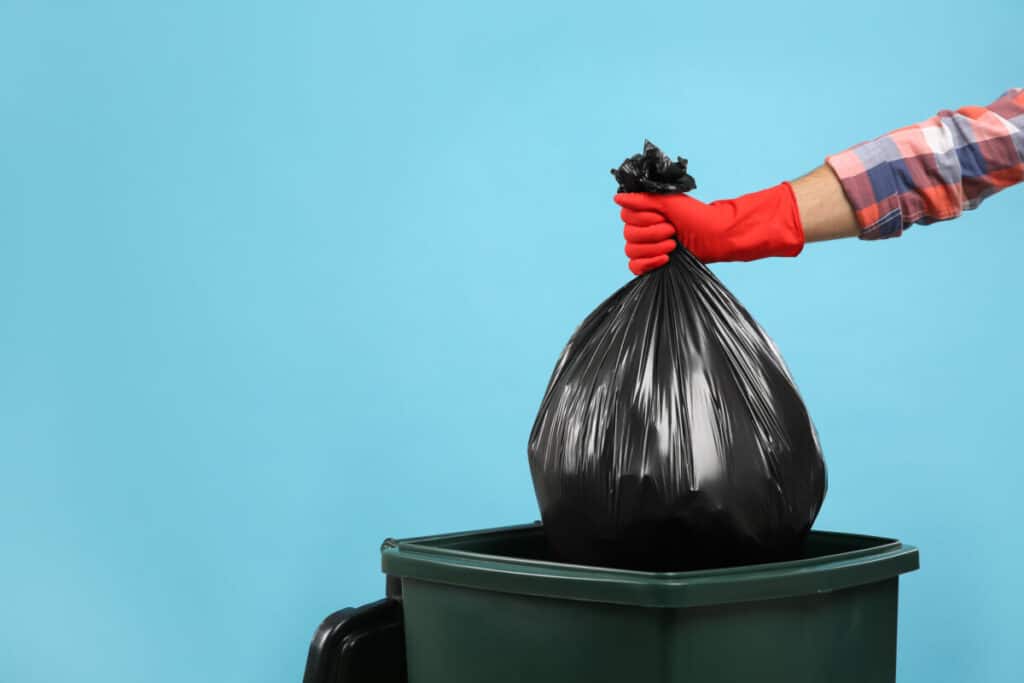
Disposing of cooking oil can be a tricky process. After cooking competitively for about a year, here are my own personal tips and tricks for safely and legally disposing of cooking oil.
To dispose of cooking oil, put it in a ziplock bag or other container after it has been cooled and throw it away. As a general rule, never pour used cooking oil down any drain. Pouring used cooking oil down the drain is illegal and can clog up the pipes and cause permanent damage.
To find out more about how to dispose of cooking oil, keep reading.
NEVER Pour Cooking Oil Down the Drain
Not only is pouring used cooking oil down the drain illegal, but it will cause damage to your pipes. Cooking oil hardens when it gets cold. Thus, when it goes down the pipes, it sticks to the cold metal or plastic and creates masses of hardened oil, blocking the water flow. This causes problems for not only you but anyone else who uses the same water system as you do. Pouring used cooking oil down drains can lead to fines and system shutdowns.
You need to dispose of the used cooking oil properly, legally, and safely by throwing it away in the garbage.
Keeping Used Cooking Oil
Before you throw your used cooking oil away, there is another option to consider. You can keep and reuse your used cooking oil for another time. However, in order to do this, your used cooking oil needs to be clean enough so that if you do choose to reuse it, it won’t burn your fried food and can meet and maintain the desired temperature.
Sometimes you only need to fry a few things, and a few cups of oil seems like a waste to use just once or twice, only to throw it into the garbage. If you would like to reuse your used cooking oil, I would suggest following a few guidelines before deciding to keep or throw it away.
It is important to note that used oil will not be of the same quality as fresh oil. Depending on how used your oil is, it can give your food a better chance of burning and can have a hard time maintaining its heat.
How Dark is It?

When pouring fresh oil into a pan, it tends to be a light to golden yellow depending on the type of oil and the amount you are using. As the oil heats up and is used to fry meats and vegetables and doughs, it begins to darken. You know your oil is ready to be changed out if it is a dark brown to black.
Your food will burn easier and faster the darker the oil is. Darkly colored oil also has a hard time maintaining the proper heat to fry your food. I personally like to change my oil just before this color change, so deciding to keep the used oil when it is that dark does not make sense to me.
When trying to decide if the oil is too dark, you don’t want to keep anything over about 4 shades darker than the original color. While it may not be at the point where you’d want to change it, you won’t be able to get as much frying time at the quality of fresh oil when used again if it is darker.
What Did You Put in It?
During your frying experience, did you use just oil? Or did you add something to it? If you added spices, like salt, or anything else, I would suggest throwing it out. The next time you want to fry food, you may not want to have the flavors you added previously on the food you are currently making.
Maybe it was just oil at first, but now you have numerous amounts of floaties. If your oil is still a good color, it may not hurt to try and remove as many floaties as possible. This can be done with a spoon, a fork, sieve, or mesh strainer depending on the size of your floaties.
Making the used oil as clean as possible will prolong the used oil’s shelf life and help it be the best quality it can be for when you use it again.
When Do You Plan on Frying Again?
This is probably the most crucial question to ask yourself before deciding on keeping your used cooking oil or throwing it out. Used cooking oil does not have the same shelf life as unused oil does. Because it has already been used, the oil is full of food particles that can and will attract bacteria and mold. If you are planning on frying within the next week, storing your used oil shouldn’t be a problem.
If you don’t know when the next time you will be frying food is, you should likely throw it out. It’s not worth the potential new ecosystem of fuzzy bacteria.
Storing Used Cooking Oil
I have found the best way to store used cooking oil is by keeping the liquid in mason jars. Transfering the used oil from pan to container can be an adventure. I would suggest using a funnel. However, if one cannot be found, carefully pouring the used oil into the jar in the sink on a plate or bowl works just fine. That way, if the used oil does spill, you can dispose of it properly by throwing it into the trash.
If you do not have a jar, really any water-proof container will do. I prefer using jars or plastic containers over ziplock bags because they tend to be less of a mess. A ziplock bag can get lost or pop a bit more easily than a jar or plastic container. It’s also easier to estimate how much-used oil you have in a jar versus a bag.
Used Oil’s Shelf Life

Once your used oil is in a jar or container, its shelf life is about a week. If you want it to last just a bit longer, putting it into the fridge may be a good idea. Doing this could give you about another week. However, it takes longer to heat up and could harden depending on how cold your fridge is and how much used oil you have.
Hardened used oil is not the easiest to deal with. It won’t ever melt to be quite the same consistency as it was before. Thus, I would suggest keeping the oil out of the fridge and just putting it on the shelf.
Stored used cooking oil should be thrown away after about its second use. This helps keep down the number of bacteria, it won’t mess with your oil heat when cooking food, and it will reduce the chance of burning your fried food. However, it is not uncommon to keep oil for another time if it still passes the above recommendations.
Reusing Used Cooking Oil
When you are ready to use your stored used cooking oil, simply open the container and check for mold. Depending on how dark the used oil is and how many floaties it has, giving the used oil a good stir might not be a bad idea. This will mix all of the excess fat that may have floated to the top back into the used oil.
Pour the used oil into a cold pan and heat it up to the desired temperature. Pouring it into a cold pan will reduce the likelihood of burning your oil and help keep you safe from hot oil splashes. You can add more oil to your used cooking oil to get the right amount. Adding fresh oil to used oil can reset the process of deciding to keep or throw out the used cooking oil once you are done with it. Adding fresh oil will also help the used oil maintain its heat and reduce the likelihood it will burn your food.
Throwing Away Used Oil

Because pouring used oil down the drain will clog the pipes and is illegal, you must throw your used oil into the trash. DO NOT just pour loose, hot oil into your garbage can. If the garbage has a bag and your oil is hot, it will melt through the bag and coat the inside of the garbage can, which will not be fun to clean up. If the oil is cold when you pour it into the garbage, it will pool up at the bottom and could leak if our bag gets a hole.
To properly, legally, and safely dispose of used cooking oil, there are a few steps you should follow.
Let it Cool
First things first, you should always let your used oil cool down before doing anything with it. Whether it is throwing the used oil away or storing it to be used for later, your used oil should be cool before you handle it. This will keep you safe from oil burns, it will protect your containers from melting, warping, or cracking and breaking, and it will be easier to deal with in general because it won’t be popping and splattering everywhere.
The best way to cool down your oil is by removing your pan or pot from heat and just letting the oil sit for an hour or two until it is room temperature. However, if you are in a hurry, you can give it an ice bath.
Please note that giving your hot oil an ice bath can damage your pot or pan. When going from a very hot temperature to a very cold one, some materials can warp or even crack and break. I would not recommend an ice bath unless it is an emergency to cool down your oil and you know your pot or pan can handle it.
Giving your oil an ice bath is very simple. It is best done in the sink. Simply fill your sink with ice until the bottom of your sink is no longer visible. Then, fill it with cold water until the ice is covered, and add your pot, pressing it into the ice so the ice surrounds the pot on all sides, including the bottom.
Stir the used oil around to help the cooling process happen faster. That way, the cold used oil against the sides of the pot or pan gets mixed into the hot oil in the middle until the whole pot or pan of used oil is cold. This cooling process only takes a few minutes. If you leave your used oil in the ice bath for longer than needed to cool, the used oil could harden into clumps.
Picking an Appropriate Container
After your used oil is cool, you will want to pick an appropriate container to house your used oil to be thrown away. Be sure you don’t pick anything you might want to use later. I would suggest a ziplock or grocery bag. Make sure you have more bag space than used oil.
Once you have selected the appropriate container or bag, I would suggest getting a friend to help you pour the used oil. If you have chosen a bag, you might want another set of hands to hold the bag open while you pour the used oil into the bag or vice versa. Be patient and don’t rush this part. You don’t want to have to clean up used cooking oil from your stove or countertop.
Once all of your used cooking oil is inside the bag or container, seal or tie it closed and bag it again. If you have used a ziplock bag, put it in a grocery sack or another ziplock. If you have used a grocery sack, put it in another grocery sack. If you put it into a container, put it in a grocery sack.
Double bagging your used oil will help prevent spilling while in the garbage bag. It is the safest way to dispose of used cooking oil.
Throw the Used Cooking Oil Away

Once your used oil has been poured into its appropriate container, you can throw it away. Simply put that bag of used cooking oil in the trash and stop thinking about it.
Once you know how to dispose of cooking oil, it is extremely easy to do.
Related Topics:
If you like the article above, here are some other similar articles you should check out!
